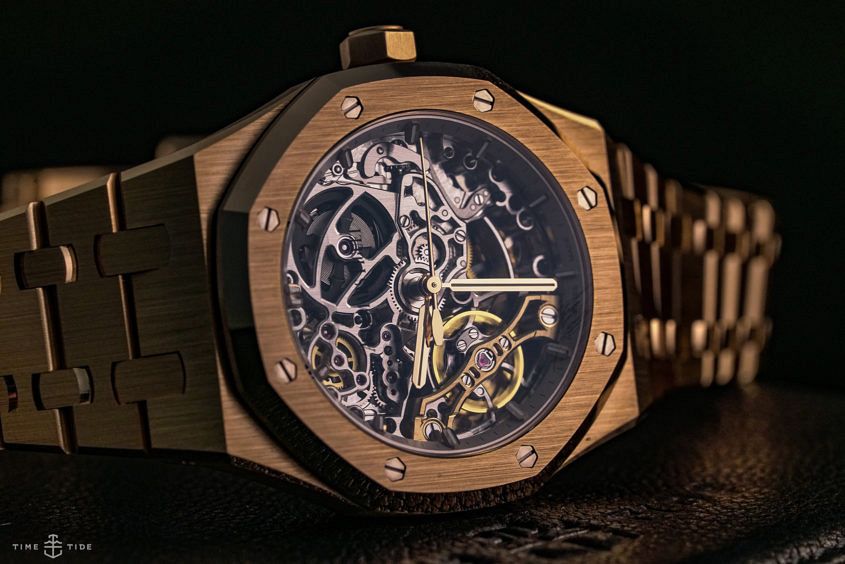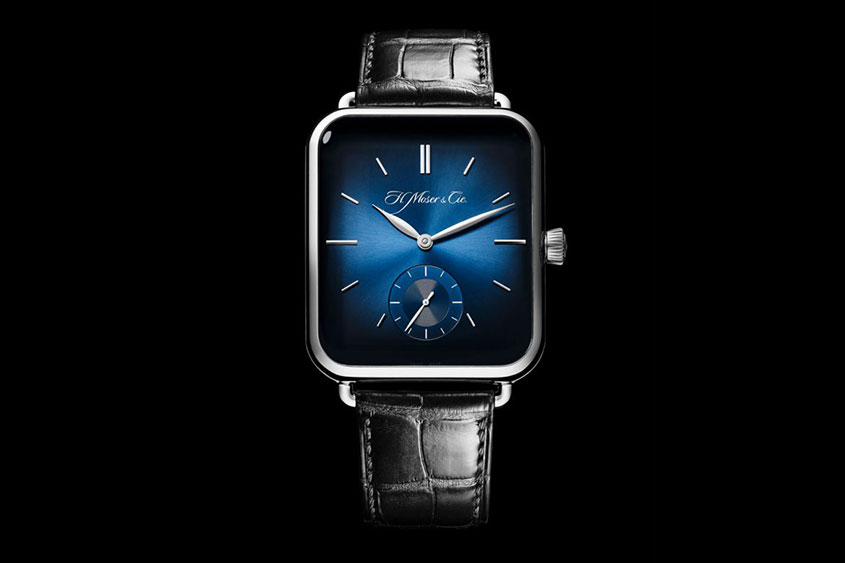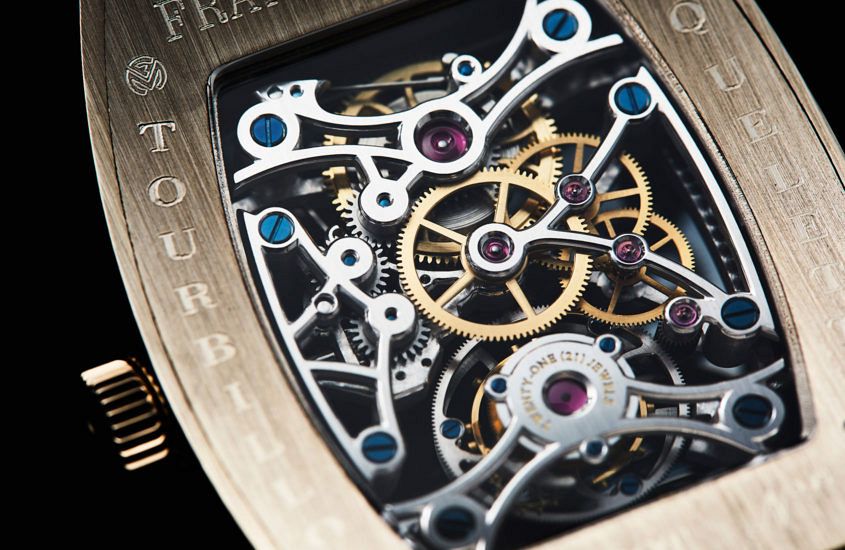Introducing: The IWC Big Pilot’s Watch Edition ‘Right-Hander’
For the first time we’ve got a Big Pilot with a crown on the left.
For the first time we’ve got a Big Pilot with a crown on the left.
What’s the best way to create a watch that customers want? Well, literally ask them what design elements and specifications are most appealing. Pinion, a rising microbrand based in London, posted an online survey on its website in September 2018 and applied the feedback to its latest tool watch, the Atom 39. This is a follow-up to the original Atom from 2017, which featured a 41mm diameter case, black dial and Japanese Miyota 9015 automatic. The new Atom 39 reduces the size to 39mm, offers a white dial variant and upgrades the movement to a Swiss ETA automatic, all based on public feedback.
 Watch collecting has never been more present in the public consciousness. Before the quartz revolution of the 1970s, the idea of collecting watches was probably akin to collecting modern vacuum cleaners. It just didn’t make much sense. An old watch wasn’t vintage; it was just old. And a watch that was still ticking, and keeping time to a reasonable degree? Well, that was just fine and dandy. Perhaps a very well-to-do man might have had one watch for work, and another for special occasions, but these faithful companions would have been expected to remain with him for years and years and years. The notion of forming a watch collection only really emerged when the technology of mechanical watches became functionally obsolete, and the true classics of what seemed for so long to be a permanently bygone era were appreciated for their artistry beyond their base function of telling the time. Now every man and his dog is hunting through garage sales, hoping to find a beautiful, tropical dial Rolex that some unwitting seller has failed to recognise. But this widespread awareness of a vintage watch’s potential value has done some funny things to the market for preloved and brand new…
Watch collecting has never been more present in the public consciousness. Before the quartz revolution of the 1970s, the idea of collecting watches was probably akin to collecting modern vacuum cleaners. It just didn’t make much sense. An old watch wasn’t vintage; it was just old. And a watch that was still ticking, and keeping time to a reasonable degree? Well, that was just fine and dandy. Perhaps a very well-to-do man might have had one watch for work, and another for special occasions, but these faithful companions would have been expected to remain with him for years and years and years. The notion of forming a watch collection only really emerged when the technology of mechanical watches became functionally obsolete, and the true classics of what seemed for so long to be a permanently bygone era were appreciated for their artistry beyond their base function of telling the time. Now every man and his dog is hunting through garage sales, hoping to find a beautiful, tropical dial Rolex that some unwitting seller has failed to recognise. But this widespread awareness of a vintage watch’s potential value has done some funny things to the market for preloved and brand new…
The post 5 affordable vintage watch options appeared first on Time and Tide Watches.
 Some of my favourite releases from SIHH 2019 were the watches from the IWC Spitfire collection, which offers a host of twists on their classic pilot’s collection, and a few special limited editions — like the Timezoner Spitfire Edition “The Longest Flight”. At SIHH we also learned more about the story of this watch, or rather the adventure it takes its name from, and which IWC is supporting. The Silver Spitfire was originally constructed in 1943, and took part in 51 sorties between 1944 and 1945. The old bird (known by the registration G-IRTY) has been given a fresh lease on life, and completely stripped of paint, leading to the name — The Silver Spitfire. And today it takes off in an epic attempt to circumnavigate the globe, in a trip that will see the plane (and two pilots) fly 27,000 miles and visit 30 countries over four months. Impressive, inspiring stuff. Read more about the plane, its importance and its journey (and the occasional IWC watch) over at QP Magazine.
Some of my favourite releases from SIHH 2019 were the watches from the IWC Spitfire collection, which offers a host of twists on their classic pilot’s collection, and a few special limited editions — like the Timezoner Spitfire Edition “The Longest Flight”. At SIHH we also learned more about the story of this watch, or rather the adventure it takes its name from, and which IWC is supporting. The Silver Spitfire was originally constructed in 1943, and took part in 51 sorties between 1944 and 1945. The old bird (known by the registration G-IRTY) has been given a fresh lease on life, and completely stripped of paint, leading to the name — The Silver Spitfire. And today it takes off in an epic attempt to circumnavigate the globe, in a trip that will see the plane (and two pilots) fly 27,000 miles and visit 30 countries over four months. Impressive, inspiring stuff. Read more about the plane, its importance and its journey (and the occasional IWC watch) over at QP Magazine.
The post RECOMMENDED READING: The Silver Spitfire’s epic 27,000-mile trip starts today (and IWC is on board) appeared first on Time and Tide Watches.
 Editor’s note: Make no bones about it, skeleton watches are not to everyone’s taste. Legibility is sometimes less clear than a watch with a solid dial, but this is because time telling is almost ancillary to the stunning exposé that the watch offers. A skeleton dial offers a view typically reserved for a watchmaker in search of a problem, with any warmth offered by the layperson’s intrigue, evaporated under the cool white lights of a workbench. So let’s take another look at one of the best-looking skeleton dials out there. One of the finest open-worked watches on the market right now (and one that, paradoxically, didn’t make our list of skeletonised watches) is the Royal Oak Double Balance Wheel Openworked from Audemars Piguet. Visually, this pink gold case, with predominantly steel movement architecture, is everything you’d expect — that classic RO case and bracelet looking boss, with a deep, complex open-worked dial. And while legibility is the main concern here (there’s not a heap of contrast between the movement and those gold hands, compared to earlier versions with a grey movement finish), it quickly becomes apparent that the titular double balance, nestled at eight o’clock is the star of the…
Editor’s note: Make no bones about it, skeleton watches are not to everyone’s taste. Legibility is sometimes less clear than a watch with a solid dial, but this is because time telling is almost ancillary to the stunning exposé that the watch offers. A skeleton dial offers a view typically reserved for a watchmaker in search of a problem, with any warmth offered by the layperson’s intrigue, evaporated under the cool white lights of a workbench. So let’s take another look at one of the best-looking skeleton dials out there. One of the finest open-worked watches on the market right now (and one that, paradoxically, didn’t make our list of skeletonised watches) is the Royal Oak Double Balance Wheel Openworked from Audemars Piguet. Visually, this pink gold case, with predominantly steel movement architecture, is everything you’d expect — that classic RO case and bracelet looking boss, with a deep, complex open-worked dial. And while legibility is the main concern here (there’s not a heap of contrast between the movement and those gold hands, compared to earlier versions with a grey movement finish), it quickly becomes apparent that the titular double balance, nestled at eight o’clock is the star of the…
The post Looking through Audemars Piguet’s Royal Oak Double Balance Wheel Openworked appeared first on Time and Tide Watches.
 When you think digital watch, the first thing that comes to mind might be a Casio, with a clear digital display, a couple of functions and a light. You don’t think mechanical watch, and you certainly don’t imagine a watch that has its place in the upper echelons of haute horology. But this is exactly what you get with the A. Lange & Söhne Zeitwerk Date, a watch with a clear digital display, and now with an additional function. First released in 2009, the Zeitwerk was a new way to communicate time with a mechanical wristwatch, employing a pair of windows that respectively showed the hours and minutes, read from left to right as you would with any digital display. In an expression of Teutonic symmetry, the running seconds and power reserve are displayed at 6 o’clock and 12 o’clock respectively, giving the unusual dial layout a wonderful symmetry and sense of precision (a broader precision discussed at length here). A decade later, the Zeitwerk gets more complex, now with a date function. While this may seem a relatively trivial addition, the layout of the dial meant adding a date window would disrupt the design, wherever it was placed. The…
When you think digital watch, the first thing that comes to mind might be a Casio, with a clear digital display, a couple of functions and a light. You don’t think mechanical watch, and you certainly don’t imagine a watch that has its place in the upper echelons of haute horology. But this is exactly what you get with the A. Lange & Söhne Zeitwerk Date, a watch with a clear digital display, and now with an additional function. First released in 2009, the Zeitwerk was a new way to communicate time with a mechanical wristwatch, employing a pair of windows that respectively showed the hours and minutes, read from left to right as you would with any digital display. In an expression of Teutonic symmetry, the running seconds and power reserve are displayed at 6 o’clock and 12 o’clock respectively, giving the unusual dial layout a wonderful symmetry and sense of precision (a broader precision discussed at length here). A decade later, the Zeitwerk gets more complex, now with a date function. While this may seem a relatively trivial addition, the layout of the dial meant adding a date window would disrupt the design, wherever it was placed. The…
The post A. Lange & Söhne Zeitwerk Date – the digital watch with no battery appeared first on Time and Tide Watches.
You may not have heard this story – and there’s a good reason why.
 Editor’s note: Many executives in the Swiss watch industry are boring. They went to finance school, and they sell watches by looking at a balance sheet, never finding any of the watches in their own catalogue inspiring, and therefore never inspiring anyone to buy one. This could not be further from the truth for Edouard Meylan, the CEO of H. Moser & Cie. In this interview he gives a crash course on start-up marketing in the watch world (where interesting strategies have come to life recently), and discusses why he was once waiting for legal letters from Apple. It’s both reassuring and alarming to discover that H. Moser & Cie. CEO Edouard Meylan is a human version of his brand’s watches: he is stylish, sophisticated, smart (more on that later) and in possession of a sense of humour that is never too far from the surface. He’s also refreshingly direct and far from complacent about the favourable position he currently finds himself in. All of which adds up to a boss who’s well placed to bring the old, established name of Moser back into the spotlight. I sat down with Edouard in Sydney yesterday, and received a crash course in brand-building 101 from the…
Editor’s note: Many executives in the Swiss watch industry are boring. They went to finance school, and they sell watches by looking at a balance sheet, never finding any of the watches in their own catalogue inspiring, and therefore never inspiring anyone to buy one. This could not be further from the truth for Edouard Meylan, the CEO of H. Moser & Cie. In this interview he gives a crash course on start-up marketing in the watch world (where interesting strategies have come to life recently), and discusses why he was once waiting for legal letters from Apple. It’s both reassuring and alarming to discover that H. Moser & Cie. CEO Edouard Meylan is a human version of his brand’s watches: he is stylish, sophisticated, smart (more on that later) and in possession of a sense of humour that is never too far from the surface. He’s also refreshingly direct and far from complacent about the favourable position he currently finds himself in. All of which adds up to a boss who’s well placed to bring the old, established name of Moser back into the spotlight. I sat down with Edouard in Sydney yesterday, and received a crash course in brand-building 101 from the…
The post Why Edouard Meylan sells watches smarter appeared first on Time and Tide Watches.
 With a name that sounds like it comes straight from the Marvel Cinematic Universe, it should come as no surprise that the watch looks more than a little out of this world. First of all there’s the dial — or rather the lack of it. Because as you might guess with a name like “Skeleton X”, the dial of this watch is pretty extensively open-worked, offering the wearer a beautifully worked gear train, as well as a whole lot of negative space. The bridges — slight as they may be — form the ‘X’, around a box-like aperture, with the bottom and top aspects of the X framing the escapement and power barrel respectively. This is a thoroughly modern take on a classically skeletonised watch. And while the architecture is aggressive enough, it’s got nothing on the case, which is made from a material called Carbonium. You don’t need to be a particularly cunning linguist to work out that carbon fibre plays an important role in this material. And by the same token, you need not be the most observant fellow to ascertain that this carbon is riddled with gold inflections. It’s a cutting-edge technical material, lightweight and hard-wearing, with a…
With a name that sounds like it comes straight from the Marvel Cinematic Universe, it should come as no surprise that the watch looks more than a little out of this world. First of all there’s the dial — or rather the lack of it. Because as you might guess with a name like “Skeleton X”, the dial of this watch is pretty extensively open-worked, offering the wearer a beautifully worked gear train, as well as a whole lot of negative space. The bridges — slight as they may be — form the ‘X’, around a box-like aperture, with the bottom and top aspects of the X framing the escapement and power barrel respectively. This is a thoroughly modern take on a classically skeletonised watch. And while the architecture is aggressive enough, it’s got nothing on the case, which is made from a material called Carbonium. You don’t need to be a particularly cunning linguist to work out that carbon fibre plays an important role in this material. And by the same token, you need not be the most observant fellow to ascertain that this carbon is riddled with gold inflections. It’s a cutting-edge technical material, lightweight and hard-wearing, with a…
The post HANDS-ON: The Ulysse Nardin Executive Skeleton X in Carbonium Gold appeared first on Time and Tide Watches.
 Jewels are typically things you imagine adorning lavishly dressed socialites, or existing in piles that form the sleeping places of greedy dragons, so why are they so important in watchmaking? The reason is not frequently talked about, despite the number of jewels in a movement being communicated as a standard piece of mechanical information, and generally an indication of the quality of the movement. But it still begs the question: why are there jewels in a watch? As they discuss, the main reason for them is not decorative, but the properties of their synthetic mineral hardness. Apart from diamond, rubies are one of the hardest materials in the world, making them perfect to reduce friction in the gear train of the movement. Without them, the increased resistance in the movement would not only make the watch less accurate, but also increase the frequency the watch required servicing. This is a good thing for watch owners, as generally the happiest visits to your nearest boutique are because of a new purchase, not because your watch stopped working. Read the full article here.
Jewels are typically things you imagine adorning lavishly dressed socialites, or existing in piles that form the sleeping places of greedy dragons, so why are they so important in watchmaking? The reason is not frequently talked about, despite the number of jewels in a movement being communicated as a standard piece of mechanical information, and generally an indication of the quality of the movement. But it still begs the question: why are there jewels in a watch? As they discuss, the main reason for them is not decorative, but the properties of their synthetic mineral hardness. Apart from diamond, rubies are one of the hardest materials in the world, making them perfect to reduce friction in the gear train of the movement. Without them, the increased resistance in the movement would not only make the watch less accurate, but also increase the frequency the watch required servicing. This is a good thing for watch owners, as generally the happiest visits to your nearest boutique are because of a new purchase, not because your watch stopped working. Read the full article here.
The post RECOMMENDED READING: Why are there jewels in a watch? appeared first on Time and Tide Watches.